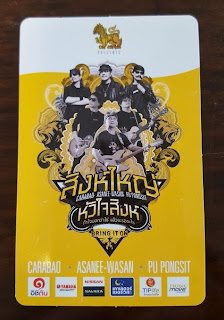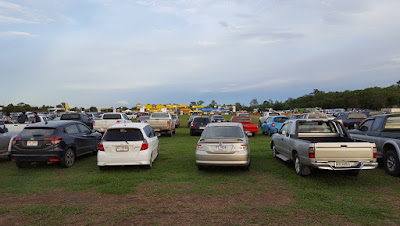Here are some pictures of His Majesty covered by a few major publications:
Monday 24 October 2016
RIP His Majesty King Bhumibol Adulyadej
His Majesty King Bhumibol Adulyadej passed away on 13 October 2016, Siriraj Hospital, Bangkok. A truly great man who devoted his life to improving the lives of the millions of Thais in the country, he will be sorely missed and remembered always.
Friday 23 September 2016
Satisfaction Level Up for MRT Service - Sure or Not?
Saw an interesting article in the Singaporean newspaper, The Straits Times yesterday. Apparently, despite experiencing train breakdowns every other day, "consumers have grown more satisfied with the MRT as well as the overall land transport sector in the past year."
Here is the report:
http://www.straitstimes.com/singapore/transport/satisfaction-level-up-for-mrt-service-survey
I have never trusted surveys, that has anything remotely anything to do with the the Government, conducted by 'independent' organisations such as universities, the Institute of Policy Studies etc. This is because these people know which side their bread is buttered on.
In this case, just imagine what they are trying to tell you: a service provider inconveniences you often but yet, you become more satisfied with their service. Simply wow. If this is not a royal load of bullshit, I do not know what is. And, judging by online comments in various forums and websites, I am not the only one who thinks so.
Apparently, the people in charge think that Singaporeans are dumb enough to believe everything that they are told and, sad to say, I think they are right or at least, 70% of Singaporeans are.
Here is the report:
http://www.straitstimes.com/singapore/transport/satisfaction-level-up-for-mrt-service-survey
I have never trusted surveys, that has anything remotely anything to do with the the Government, conducted by 'independent' organisations such as universities, the Institute of Policy Studies etc. This is because these people know which side their bread is buttered on.
In this case, just imagine what they are trying to tell you: a service provider inconveniences you often but yet, you become more satisfied with their service. Simply wow. If this is not a royal load of bullshit, I do not know what is. And, judging by online comments in various forums and websites, I am not the only one who thinks so.
Apparently, the people in charge think that Singaporeans are dumb enough to believe everything that they are told and, sad to say, I think they are right or at least, 70% of Singaporeans are.
Monday 15 August 2016
Electronic Fly Swatter
When I first came to Chiangmai, I was pleasantly surprised to find that electronic fly swatters were commonly used here. Everyone knows how difficult it is to swat a small flying insect, especially mosquitoes, with your hands and this electronic swatter was a godsend (especially when you are trying to kill a mosquito in the dead of night in your bedroom).
It is simple and fun to operate - press and hold down a button on the handle of the device and this sends an electrical current to the wire mesh at its head. Next, bat an insect with the device and it will be fried instantly (with a loud crackling sound and electrical spark!) as soon as it comes into contact with the mesh.
I have seen these swatters being sold in the Mustapha store in Singapore but it is strange why they are not widely used there.
Tuesday 9 August 2016
Bought New Monthly Disposable Contact Lenses
Just got a year's supply of monthly disposable contact lenses yesterday as well. I am very short-sighted (more than 600 degrees in each eye) and hate wearing glasses so this leaves me with contact lenses as the only solution (of course, Lasik is always available but I am not going for surgery unless necessary).
I was not familiar with the brand above but the optician recommended it to me a couple of years ago. I was using Bausch and Lomb soft lens previously but was having trouble with dry eyes as the lenses were apparently too thick for me. I got started on this brand and the problem cleared up promptly. I have also never had any problems with it to date.
I got them at a great price as well. 12 pairs of lenses for about 2250 baht (about SGD 90) as compared to what I used to pay in Singapore at the optical shop - SGD 160 to 220. I think there are some great deals to be found on online optical stores as well but if you are one of those people who prefer not to shop at these places for one reason or another (e.g. not IT-savvy, cannot be bothered to find out your required measurements, do not trust online stores etc), stocking up on your lenses overseas is another option.
I was not familiar with the brand above but the optician recommended it to me a couple of years ago. I was using Bausch and Lomb soft lens previously but was having trouble with dry eyes as the lenses were apparently too thick for me. I got started on this brand and the problem cleared up promptly. I have also never had any problems with it to date.
I got them at a great price as well. 12 pairs of lenses for about 2250 baht (about SGD 90) as compared to what I used to pay in Singapore at the optical shop - SGD 160 to 220. I think there are some great deals to be found on online optical stores as well but if you are one of those people who prefer not to shop at these places for one reason or another (e.g. not IT-savvy, cannot be bothered to find out your required measurements, do not trust online stores etc), stocking up on your lenses overseas is another option.
Minoxidil in Thailand
Battling male pattern hair loss is a much cheaper affair in Thailand than in Singapore. I just got a new month's supply of minoxidil (30ml bottle) from the pharmacy today. The price - 170 baht (SGD 7). I used to buy my minoxidil from the pharmacies in Singapore and it cost about SGD 60 onwards. And this is for generic brands and not even famous ones like Regaine.
If you need products for treating hair loss (e.g. Propecia, Proscar, Nizoral shampoo, minoxidil), these are much cheaper in Thailand than in Singapore.
If you need products for treating hair loss (e.g. Propecia, Proscar, Nizoral shampoo, minoxidil), these are much cheaper in Thailand than in Singapore.
Sunday 7 August 2016
Thai Ingenuity: Maximising Cargo Space on Goods Vehicles
Shipping goods by road via pickups and lorries is an
inexpensive and efficient way of transporting many types of goods in Thailand . And
since the drivers are often paid by how much cargo they move rather than a flat
rate per trip, it makes sense for the drivers to load as much cargo as they can
per trip so that they will maximise their earnings.
 |
| The platform on the back of the vehicle is lowered to create more space. |
The goods are often stacked high up on the backs of these pickups and lorries and metal cages are usually used to create more storage space as well as to keep the cargo in place. Ropes and other implements are often used to hold the cargo down for added stability.
Thai Ingenuity: Tyre Crash Barriers
Here is an easy and inexpensive way of making
vehicle crash barriers – just get some old tyres, paint them in bright
colours, and then hang them up!
Roti Prata vs Rotee
About Roti Prata
Roti prata is one of the signature dishes of Singapore .
It is a round pancake-like flat bread that is cooked over an oiled flat grill.
Roti means 'bread' and prata means 'flat' in the Hindi language. It can be
eaten at all times of the day but many people tend to eat it for breakfast or
supper.
The standard roti prata is made up of fat, eggs, flour and
water. It is sold mostly by Indian Muslims at coffeeshops and hawker centres
around Singapore .
It is usually eaten with a vegetable/meat/fish-based curry on the side while
non-spicy eaters often eat it with a sprinkling of sugar on top. Variations of
the standard roti prata include prata cooked with cheese, onions, bananas,
chocolate, eggs, and even durians.
About Rotee
However, a big difference between roti prata and rotee is
that, while both are fried in oil, rotee is usually served with a generous
sprinkle of sugar and condensed milk on top, regardless of which topping you
choose – while sinfully sweet and delicious, it is definitely not recommended
for those who are watching their calories!
Thursday 4 August 2016
Japanese Food - Yayoi at Central Festival
Had Japanese food for dinner with the missus at Yayoi Japanese Restaurant at Central Festival yesterday. The food was average but it was sure value for money. The entire meal plus drinks cost about 820 baht (SGD 33).
 |
| Started with a salmon salad. |
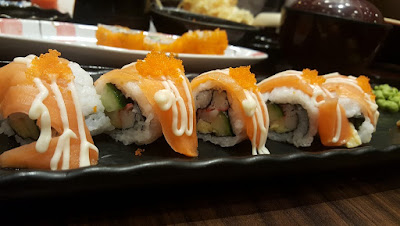 |
| Some sushi... |
 |
| A shrimp tempura set. |
 |
| A beef bento set. |
Thursday 7 July 2016
The King's Royal Project
Dropped by the King's Royal Project shop on the way home from the Doi Kham temple today. This is one of my favourite places for fresh produce as the items are really fresh and reasonably priced.
About the Royal Development Projects
His Majesty, King Bhumibhol Adulyadej, had devoted his time, energy, and life to improving the lives of the Thai people and the development of Thailand all these years. His extensive travels to all parts of Thailand over the years have given him first-hand knowledge of the problems and difficulties facing the Thai people. This inspired him to set up thousands of development projects nationwide with the aim of raising the standard of living in Thailand.
Since 1952, His Majesty King Bhumibhol Adulyadej has initiated more than 3,000 royal development projects in various areas including agriculture, water conservation, healthcare, education etc.
About the Royal Development Projects
His Majesty, King Bhumibhol Adulyadej, had devoted his time, energy, and life to improving the lives of the Thai people and the development of Thailand all these years. His extensive travels to all parts of Thailand over the years have given him first-hand knowledge of the problems and difficulties facing the Thai people. This inspired him to set up thousands of development projects nationwide with the aim of raising the standard of living in Thailand.
Since 1952, His Majesty King Bhumibhol Adulyadej has initiated more than 3,000 royal development projects in various areas including agriculture, water conservation, healthcare, education etc.
About the King’s Royal Project
The King’s Royal Project is a development project that was started after His Majesty King Bhumibhol Adulyadej visited the northen hill-tribes of Doi Pui in 1969. During the visit, His Majesty King Bhumibol Adulyadej observed that farmers there were using the slash and burn method to clear land for growing crops. This reduced the forests to ashes, resulted in deforestation, and also caused other adverse effects on the environment. He also saw that the farmers were growing poppy plants, used to make opium, which was illegal and undesirable.
His Majesty King Bhumibhol Adulyadej then started the King’s Royal Project with the intention of using alternative crops to replace the poppy plants. These crops generated more income for the farmers than poppies and helped to reduce poverty, opium production, and deforestation, at the same time.
Today, the King’s Royal Project provides high quality fruits, vegetables, flowers, beverages, sauces, personal care items etc to consumers in Thailand as well as overseas under the ‘Doi Kham’ brand - all of the produce meet Good Agricultural Practices (GAP) regulations. Not only does the project give Thais easier and cheaper access to food that were originally grown abroad only, it provides employment to thousands of Thais and is also a model of sustainable and profitable farming.
The King’s Royal Project is a development project that was started after His Majesty King Bhumibhol Adulyadej visited the northen hill-tribes of Doi Pui in 1969. During the visit, His Majesty King Bhumibol Adulyadej observed that farmers there were using the slash and burn method to clear land for growing crops. This reduced the forests to ashes, resulted in deforestation, and also caused other adverse effects on the environment. He also saw that the farmers were growing poppy plants, used to make opium, which was illegal and undesirable.
His Majesty King Bhumibhol Adulyadej then started the King’s Royal Project with the intention of using alternative crops to replace the poppy plants. These crops generated more income for the farmers than poppies and helped to reduce poverty, opium production, and deforestation, at the same time.
Today, the King’s Royal Project provides high quality fruits, vegetables, flowers, beverages, sauces, personal care items etc to consumers in Thailand as well as overseas under the ‘Doi Kham’ brand - all of the produce meet Good Agricultural Practices (GAP) regulations. Not only does the project give Thais easier and cheaper access to food that were originally grown abroad only, it provides employment to thousands of Thais and is also a model of sustainable and profitable farming.
Sunday 3 July 2016
Roadside Lucky Draw
This is a very popular game of chance and it can be found at many roadside eateries and mom-and-pop convenience stores. Many of them have it as it is a lucrative source of side income.
The game consists of two boards - one has rows of little folded pieces of paper, each bearing a number, stapled to it while the other holds the prizes that you can win, again each bearing a number.
Every three baht (about SGD 0.13) entitles you to a try. You tear a piece of paper from the first board to reveal the number within (you can buy as many chances as you like). If the number matches any of the prizes on the other board, you win that prize. If it does not, you get nothing. Prizes range from soft drinks, beer, liquor, and cash in various denominations of up to 1000 baht (about SGD 400). If you do not like the non-cash items, you can sell them back to the shop for a lower than market price.
Winning a prize is not easy. The odds are already low to begin with and when the pieces of paper left on the board get too few (and the chances of winning get higher), the operator will replace the board with a new one and the odds of winning become low again. However, I have ever won a bottle of scotch whisky within 10 tries but soon regretted it as it tasted funny and left me with a bad headache and hangover the next day (I suspect the liquor was fake). Theoretically, it is possible to win all of the prizes left by buying up all of the remaining pieces of paper left on the board but I have never tried this.
This is a highly addictive game for many people. They will keep going back, hoping to win the big prizes, as the pieces of paper left get fewer and fewer. Singapore used to have this game back in the 80’s and before, known as ‘Tikam-Tikam’, but it was later banned, probably because of its addictive nature.
Monday 20 June 2016
Cantonese Cuisine in Chiangmai: Dim Sum
Bought some dim sum from a roadside restaurant for dinner yesterday. The establishment was run by a Thai Chinese family and while the selection available was decent, it could be better. This was because there were many staple dim sum dishes that they did not serve – such as congee, turnip cake, carrot cake, steamed buns, lor mai gai (Chinese glutinous rice), fried spring rolls, and fried dumplings.
This being Thailand (and in Chiangmai to boot), I did not have too high hopes of finding quality dim sum. But even so, it was a disappointment. Minced pork was the primary ingredient in most of the dishes and most of them also tasted the same. What’s more, a basket of dim sum cost 40 baht (SGD 1.60). This is fairly expensive by Thai standards as you can get a plate of basil pork with rice and a fried egg for this amount.
Larb Moo - Thai Minced Pork Salad
Larb moo is usually eaten with a side of raw vegetables, e.g. string beans, cabbage, Thai basil, and Chinese coriander, and sticky rice. Thais will take the sticky rice, press it into a small ball with their fingers, and then dip it into the gravy before eating it.
Variations of the dish include larb gai (chicken) and larb neua (beef).
Sunday 19 June 2016
These People are Running Singapore into the Ground
I read this piece news recently, that Singapore’s Neptune Orient Lines (NOL), had been sold to French container shipping firm CMA CGM, the
world's third-largest container shipping company, and will be delisted from the
Singapore stock exchange. NOL was once ranked among the five largest carriers
in the world.
The current CEO of NOL is Ng Yat Chung, who was a career
soldier and former army general. As you can see, he has no practical knowledge of
finance or shipping prior to his leadership appointments in Temasek Holdings
and NOL.
Among the reasons that Mr Ng had given for NOL’s sale, one of
them was especially interesting, he said that NOL was "a bit slow and
reluctant to change". So since he knew that NOL needed some changes, and
quickly, in order to survive, why didn’t he make them happen instead of just
going with the flow? As the CEO, he would certainly have had the power and
authority to do so.
Despite his failure, it is noteworthy that he had received
millions in remuneration in his few short years at NOL.
Actually, his failure comes as of no surprise at all. Singapore
For example, here is a list of former leaders in the
Singapore Armed Forces and where they ended up after their retirement:
There are many more of such examples in the Civil Service as
well as in Parliament. In these days where a person is required to have
relevant experience before they will be accepted for an entry level position or
even a part-time job, it is scary to think that there are individuals such as
these, who do not have the relevant knowledge and experience needed for a job,
but are yet parachuted into management positions and are in charge of making
policies that affect the lives of countless people and their families. As such,
it is of no surprise that many fail, screw up the organisations they were asked
to helm, and screw up millions of the lives in the process.
And, judging by the take up rate, these people are obviously
not shy or embarrassed about getting on the gravy train (often at taxpayers
expense) and get paid so much for doing so little (or for screwing up).
Saturday 18 June 2016
Thai Ingenuity: Multi-Purpose Weight
This home-made weight is commonly seen in Chiangmai. It is made by pouring cement into a section of PVC pipe and then sticking a metal stud into the middle.
This can be used for various purposes, for example, as a:
This can be used for various purposes, for example, as a:
- Door stop. This is especially effective when there are strong winds.
- Weight to hold items and sheets of plastic or cloth down.
- Base for attaching thin poles to. Hawkers use the poles to display their products or to hang their banners from.
- Anchor. The bottom ends of PVC banners are usually tied to the weight to keep the banner in place and to prevent it from flapping around.
- Any other use that you can think of.
Clean Drinking Water From the Tap
A minor inconvenience about living in Thailand is that tap water is not safe to drink. However, this can be easily gotten around by having an indoor water filtration system in the house.
I have been using the Mazuma unit above for a couple of years already. It can be hung up as a standalone unit or made to fit into your existing sink. It cost more than 3000 baht for the entire set when I first bought it and you just need to replace the filter on top and the three canisters below it every year.
As it was time to do the replacements, I bought the parts at HomePro yesterday and had the handyman come by to to do the job today. Total bill came to 1778 baht (parts) + 350 (labour & transport) = 2128 baht (about SGD 85). I was happy as just the transportation cost alone for a handyman in Singapore can easily be SGD 50.
This is a small price to pay for the convenience of having clean drinking water from the tap.
I have been using the Mazuma unit above for a couple of years already. It can be hung up as a standalone unit or made to fit into your existing sink. It cost more than 3000 baht for the entire set when I first bought it and you just need to replace the filter on top and the three canisters below it every year.
 |
| The filter |
 |
| The canisters of carbon, resin, and ceramic |
As it was time to do the replacements, I bought the parts at HomePro yesterday and had the handyman come by to to do the job today. Total bill came to 1778 baht (parts) + 350 (labour & transport) = 2128 baht (about SGD 85). I was happy as just the transportation cost alone for a handyman in Singapore can easily be SGD 50.
This is a small price to pay for the convenience of having clean drinking water from the tap.
Thursday 16 June 2016
Words of Wisdom from the Management of Singapore Inc.
Infamous Quotes From Singapore Political Leaders
I just came across the post above today. It is so good that I simply had to share it. It is a choice pick of some of the most famous (or infamous) sayings from the current batch of Singapore's political leaders.
Singapore's political leaders are all highly educated and I have no doubt that they are smart. But then again, book-smarts is different from street-smarts (as well as common sense) and these comments show it clearly.
With these people in charge, does Singapore have a future? What do you think?
I just came across the post above today. It is so good that I simply had to share it. It is a choice pick of some of the most famous (or infamous) sayings from the current batch of Singapore's political leaders.
Singapore's political leaders are all highly educated and I have no doubt that they are smart. But then again, book-smarts is different from street-smarts (as well as common sense) and these comments show it clearly.
With these people in charge, does Singapore have a future? What do you think?
Thai Solar Calendar vs Gregorian Calendar
For other countries, the Gregorian calendar, also known as
the Western calendar or Christian calendar, is more widely used.
Difference Between the Two Calendars – Counting Years
The Thai calendar differs from the Western calendar when
counting years. Years in the Thai calendar are 543 years greater than those in
the Western calendar.
So when you are converting a year from the:
- Western to Thai calendar: add 543
- Thai to Western calendar: subtract 543
For example, the Thai year 2559 is equivalent to the Western
year 2016.
Why Should You Know This
This is important as Thais may use either the Thai or Western
in various situations. For example, the Thai calendar is often in official
documents and news reports while the Western calendar is used more in everyday
situations.
However, there is no confusion over the calendars as Thais
are well aware that of the use of both types.
This knowledge is also essential to everyday encounters. For
example, older Thais are more familiar with the Thai calendar and usually will
refer to it when referring to dates.
 |
| This expiry date is in the Western calendar format. |
 |
| This expiry date is in the Western calendar format. |
 |
| This expiry date is in the Thai calendar format. |
Tuesday 14 June 2016
How to Save When Exchanging Money in Thailand
Where and
when to change their money are questions that travellers always grapple with.
To get the best rates, should you change your money before your flight, at the
destination airport, or should you check into your hotel first and then sort it
out later?
There are
a number of ways you can get hold of Thai baht in Thailand
Things to
Take Note When Changing Money
Make sure
that:
- The notes that you have with you are in good condition i.e. clean, not crumpled, not torn, without any marks or writing on them. This is because if they are not in good condition, they can be refused.
- You have your passport with you. The moneychanger needs it for their records.
- Always check the receipt that is given to you for errors in the amount to be changed (in your home currency), exchange rate, and the final amount given (in Thai baht).
- Always check for counting errors by counting your money at the counter before walking away.
Transaction
Fees & Commissions
The moneychanger
usually does not charge any commission on the transaction. Some might even
advertise this fact prominently at their establishments. However, make no
mistake about this, changing money is not and never free. These people are in
business for profit and while they do not list their fee separately, you can be
sure that it has already been included in the exchange rate given to you.
So be
wary of people who try to charge you an extra fee for changing money and always
scrutinise the rate that you are given carefully.
The Current
Exchange Rate
You can
get info on this before leaving for Thailand
or if you have internet access, right in Thailand
While the
exchange rate you get in Thailand will always be lower than what the rates
provided by these sources (the difference is the profit taken by the
moneychangers), you can use it as a gauge to see whether what you are getting is
reasonable or not.
Where to
Exchange Money
Here are
some methods and places where you can change money, with their pros and cons.
In Your
Home Country
While it
is convenient, never change your money in your home country (including at the
airport) - you will always get a low rate if you do so. Instead, bring your
cash with you and change it in Thailand
At the
Airport
You can
also change your money at the tiny moneychanging booths within the airports in Thailand
Again,
while convenient, changing money at the airport means that you may be getting a
poor deal as the rates here are often lower than those elsewhere in Thailand
At the
Hotel
Hotels
and other places providing accommodation often provide moneychanging services.
Again, while convenient, the rates that they give are usually low as compared
to those at banks and moneychangers outside.
At the
Banks
Banks can
offer pretty good exchange rates, depending on which one you go to. As different
banks offer different rates, the easiest way of comparing them is to go to a
major shopping mall, where the various banks will often have branches located
close together, and look for the electronic display board near the entrance of
each bank. The current rates of the bank will be displayed on it.
Do note
that the rates offered by a bank will be the same across all of its branches
(with the exception of branches at the airport where the rates can be lower).
At the
Moneychangers
These are
easily found in shopping centres, tourist areas, as well on the streets. Many
of them display their rates on electronic display boards as well and their
rates can sometimes be even better than those offered by the banks.
Dynamic
Currency Conversion (DCC)
Sometimes,
a store or hotel may give you the option of paying for your purchases in your
home currency instead of in Thai baht. This is offered for the convenience of
those who wish to make a purchase on the spot but yet do not have local
currency.
While
these retailers do not offer moneychanging services per se, the fact that they
have this option means that they are effectively changing money as well, but not
for everybody, just for their customers. And like the hotels, the rates they
give are often poor.
Therefore,
always insist on paying in Thai baht in these situations, even when you are using
your credit card.
Conclusion
You will
always lose some money when exchanging it; the more you change, the more you
lose.
Differences
in exchange rates are not a big deal if you are changing just a small amount
for immediate use, e.g. taxis, food, initial expenses etc. But if you are
changing a large amount, it is best that you go to the banks and moneychangers
as they give the best rates among all of the available options. And even so, be
sure to check the prevailing exchange rates often as they fluctuate from day to
day.
Ways to Minimise or Avoid the 200 Baht ATM Withdrawal Fee
When travelling around Thailand, it is good not to carry too much cash on you in case you lose it due to carelessness or theft. Fortunately, the wide network of ATMs in the country makes it easy for you to do so.
Currency Conversion Rates
This is not a charge but as this costs you money as well, you need to watch out for it.
As the money that you withdraw is in Thai baht, the rate at which your withdrawn amount is converted from your local currency into Thai baht is determined by the issuing bank or financial institution of your card. This rate is usually less favourable than the one that you can get outside at the moneychangers.
Ways to Minimise the ATM Withdrawal Fee
Which ATM Can You Use?
Most ATMs in Thailand accept foreign bank and credit cards issued by major international banking networks and you can withdraw Thai baht from them.
To know whether an ATM accepts your bank card or credit card:
Using the ATM
ATMs in Thailand have instructions in English. For the password, you enter the same one that you use for the card in your home country.
Transaction Charges to Watch Out For
Every withdrawal transaction from Thai ATMs using a foreign bank or credit card incurs a few charges. These are charged on a per transaction basis and apply regardless of the amount withdrawn, be it 100 baht or 10000 baht. They include:
Most ATMs in Thailand accept foreign bank and credit cards issued by major international banking networks and you can withdraw Thai baht from them.
To know whether an ATM accepts your bank card or credit card:
- First, look at the logos on the front and back of your cards to see which networks your card is on. You should see logos from Cirrus, PLUS, Maestro, Visa, Mastercard etc.
- Next, look at the ATM and see whether the machine supports the networks your card is on. This will usually be displayed prominently at the front of the machine
Using the ATM
ATMs in Thailand have instructions in English. For the password, you enter the same one that you use for the card in your home country.
Transaction Charges to Watch Out For
Every withdrawal transaction from Thai ATMs using a foreign bank or credit card incurs a few charges. These are charged on a per transaction basis and apply regardless of the amount withdrawn, be it 100 baht or 10000 baht. They include:
- A 200 baht fee charged by the bank that owns the ATM.
- A fee charged by the bank or financial institution that issued your card. The fee can be a flat rate or a percentage of the withdrawn amount, depending on how they charge for this.
This is not a charge but as this costs you money as well, you need to watch out for it.
As the money that you withdraw is in Thai baht, the rate at which your withdrawn amount is converted from your local currency into Thai baht is determined by the issuing bank or financial institution of your card. This rate is usually less favourable than the one that you can get outside at the moneychangers.
Ways to Minimise the ATM Withdrawal Fee
Make Fewer Transactions
Most ATMs have a per transaction withdrawal limit of 20000 baht. Plan your spending carefully and try to withdraw the maximum amount each time so that you will need to make fewer transactions.
Take Note of the Different ATM Withdrawal Limits
Most ATMs have a per transaction withdrawal limit of 20000 baht but for some, the limit is higher, e.g. Bangkok Bank 25000 baht, Bank of Ayutthaya 30000 baht, Krungsri Bank 30000 baht.
AEON ATMs
These have a lower withdrawal fee of 150 baht per transaction but not all cards may be accepted.
Citibank ATMs
Although they are limited in number and can be hard to find, using European or UK bank cards to withdraw money from Citibank ATMs do not incur any transaction fees. However, there are apparently exceptions to this, so it is best to check beforehand on this.
United Overseas Bank (UOB) ATMs
Not sure whether this works for people with UOB accounts in other countries as well but if you have a UOB bank account in Singapore, you can withdraw Thai baht from any UOB ATM in Thailand with no transaction fee charged at all.
You can even check your account balance as well.
Most ATMs have a per transaction withdrawal limit of 20000 baht. Plan your spending carefully and try to withdraw the maximum amount each time so that you will need to make fewer transactions.
Take Note of the Different ATM Withdrawal Limits
Most ATMs have a per transaction withdrawal limit of 20000 baht but for some, the limit is higher, e.g. Bangkok Bank 25000 baht, Bank of Ayutthaya 30000 baht, Krungsri Bank 30000 baht.
AEON ATMs
These have a lower withdrawal fee of 150 baht per transaction but not all cards may be accepted.
Citibank ATMs
Although they are limited in number and can be hard to find, using European or UK bank cards to withdraw money from Citibank ATMs do not incur any transaction fees. However, there are apparently exceptions to this, so it is best to check beforehand on this.
United Overseas Bank (UOB) ATMs
Not sure whether this works for people with UOB accounts in other countries as well but if you have a UOB bank account in Singapore, you can withdraw Thai baht from any UOB ATM in Thailand with no transaction fee charged at all.
You can even check your account balance as well.
Sunday 12 June 2016
Singha Beer Concert: Carabao / Asanee Wasan / Pu Pongsit
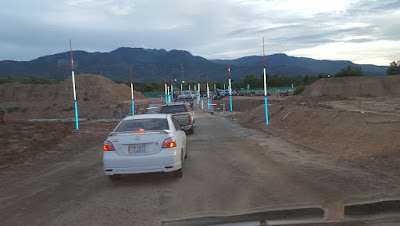 |
| The long queue in to the concert grounds |
 |
| Snaking in.... |
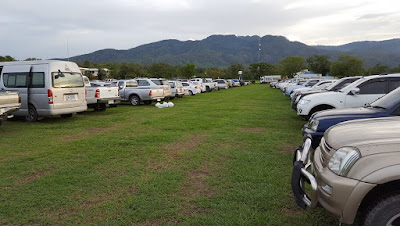 |
| Cars are starting to pack the grounds... |
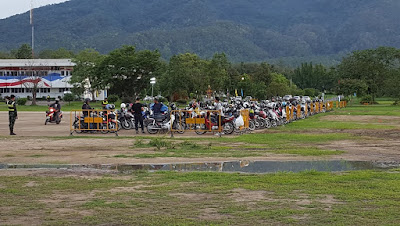 |
| Motorcycles too... |
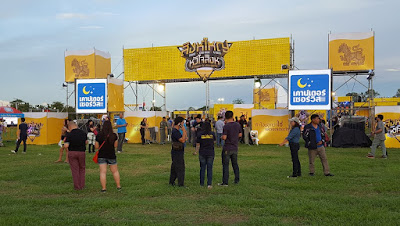 |
| The entrance |
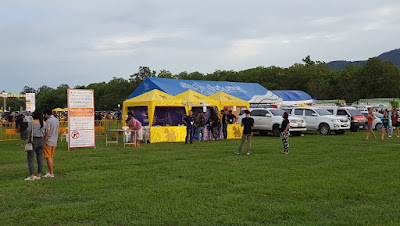 |
| Medical staff was nearby in case anyone needed help |
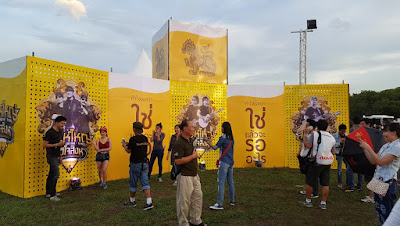 |
| Photo taking area - popular with social media enthusiasts |
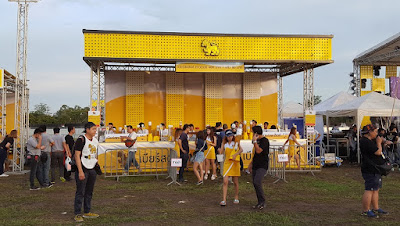 |
| Food and drinks were available. Singha beer was the beer of choice for the night. |
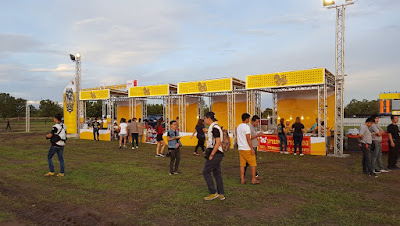 |
| Food stalls selling finger food and light snacks. |
 |
| Another photo taking opportunity - with the Singha beer lion. |
 |
| A small sample of the food that was available. Not very appetising... |
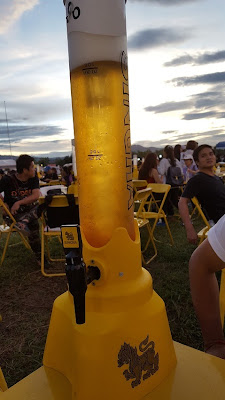 |
| 3 litres of Singha beer for 400 baht (SGD 16). A really good deal! |
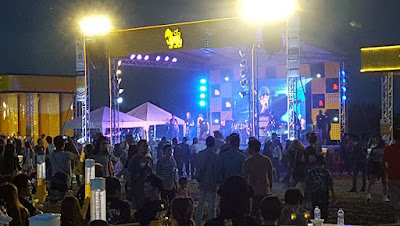 |
| Opening band for the night: Blackstone. They played a series of covers and favourite hits from various artistes. |
 |
| After the crowd had warmed up, it was time to move to the main concert ground behind. |
 |
| The main stage. |
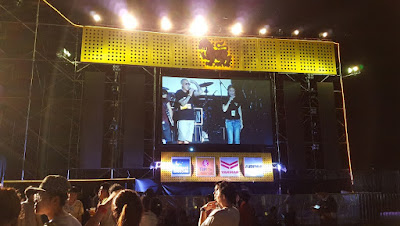 |
| Giant TV screens on each side of the stage made sure no one missed any of the action. |
 |
| Carabao was the first to take to the stage for the night. Being veteran musicians, their performance was tight and polished. |
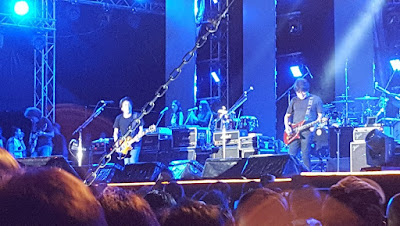 |
| Asanee Wasan came on next. They rocked the place and had fun while doing so. |
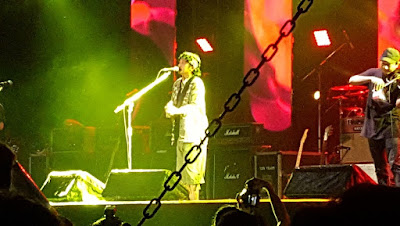 |
| Pu Pongsit was the last to come on. |
Unfortunately, i did not manage to get any videos of Pu Pongsit as my back and feet were killing me from standing throughout the concert for more than two hours. But in all, it was a great evening out.
Subscribe to:
Posts (Atom)







































